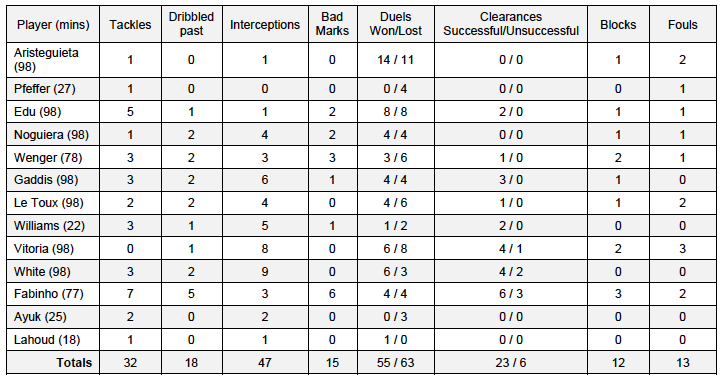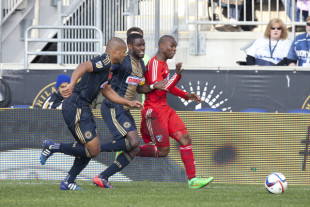Photo: Daniel Gajdamowicz
Last Saturday, difficult circumstances prevailed when Philadelphia Union ultimately conceded twice to an excellent FC Dallas side. It was an ugly game that saw an early injury to Sheanon Williams, an unfortunate red card to Zach Pfeffer, and a soft opening goal served up by Fabinho.
Despite such grim moments, the Union actually played a fairly decent game on the defensive side of the ball.
With the exception of Fabinho’s ultimately fatal error, the Union did a reasonable job of containing the Dallas attack through the efforts of Maurice Edu and Vincent Noguiera, along with Steven Vitoria and Ethan White. These four members of the central spine combined to close down the attacking space and win a great deal of balls played both through the air and on the ground in the defensive third.
The main source of concern was the continued struggle to mark along the wings, which was especially difficult given Sheanon Williams’ injury and the subsequent shuffling along the back line. Andrew Wenger did well to track back and mark when he was paired with Ray Gaddis, but struggled in his partnership with Fabinho. After struggling throughout the game, the paring ultimately miscommunicated a vital mark which led to FC Dallas’s second goal.
Before his injury, Sheanon Williams had his own struggles with Fabian Castillo’s pace. But he adapted quickly to playing conservative, positionally disciplined defense which greatly helped in containing Castillo along with the rest of FC Dallas’s attack. He did so to the tune of 3 tackles, 5 interceptions, and 2 clearances, all in a span of only 22 minutes. It was a shame that he saw his day cut short by hamstring tightness.
His early departure was unfortunate in two ways: it took him off the field, and it put Fabinho on it. In the first article I wrote for PSP, I noted that the Union allowed .63 more goals per game with Fabinho on the field, and he continued to show why.
If you were to look at Fabinho’s stats, you’d be amazed to see that he completed 7 tackles, 3 interceptions, 6 successful clearances, and 3 blocks. Unfortunately, he accomplished these actions while getting dribbled past 5 times, unsuccessfully clearing the ball 3 times, and losing his mark or keeping his teammates’ marks onside 6 times.
For an explanation of this bizarrely stuffed stat sheet, one only needs to look at the all or nothing manner in which Fabinho plays defense. He is eager to step up in order to maintain pressure and pick off passes, and either looks absolutely brilliant or gets left in his opponent’s wake. The poor clearance that gifted the opening goal was his worst mistake, but it certainly wasn’t his only one. The true shame of his play is that he really does have the physical gifts to be a decent fullback, but the enigmatic way in which he plays the game leaves fans in an uneasy mixture of amazement and dismay.
After a rough game against RSL, the Union center back duo of Ethan White and Steven Vitoria had a greatly improved outing. The pairing combined for three tackles, seventeen interceptions and eight clearances while they were forced into a series of difficult counterattacking situations. I still wouldn’t be entirely confident in their ability to defend one-on-one against elite MLS speedsters such as Castillo, but they were much more solid in their positioning along the passing and shooting lanes. Both still need to work on their distribution out of the back, but this was by far their best game of 2015.
Maurice Edu also deserves a ton of credit, especially since he had to play further forward with his team down a man. His 5 tackles and 8 successful duels represented a tireless work ethic that he showed all game, all while contributing on the offensive side of the ball as well. We’d hope that he doesn’t have to do quite so much in a full strength side, but his performance and intensity definitely bode well for the future.
Goalkeeping
Rais Mbolhi’s day can be described as up and down. He showed an excellent command of his box in completing 8 interceptions of various crosses and through balls, and made great strides in his rebound control since last week.
While he did handle crosses and through balls very well, Mbolhi showed some signs of struggle with the ball at his feet. It’s definitely something to keep an eye on as he heads out to face his old nemesis, Chicago.
His day will ultimately be remembered for his indecision on the first goal. To be fair, it was an extremely difficult circumstance to be put into, but he likely could have reached the ball if he was further up his line, and the resulting shot wasn’t necessarily an easy save, but it was definitely a shot that he’d like back.





Shouldn’t Pfeffer have 42 minutes?
.
Also, how do you track stats? I know some of them – tackles, interceptions, etc – come from the league, most likely. But for example, the “bad marks” stat. I’m assuming you track that on your own? How often do you watch the reply? Curious, is all…
Or maybe the “Goals Against – 3” stat in a 2-0 loss…
Fabinho’s turnover was so bad it counts for two on the official stats…
Yes I think the stats in this series need to be double-checked by someone else. I know the installment after last weeks game had some errors in it, at least compared to the OPTA statistics on MLS. I’m normally not too persnickety about the details in these articles, but I figure if the article is purely about statistics that the stats should be correct…and actually a measurable statistic (re: “bad marks”)
Embarrassing collection of typos right there. Had Pfeffer’s number next to his name and put it in by accident, my aplogies. As for the tracking of stats, I come up with the a number of them on my own. For example: MLS would tell you that the team had twelve total fouls, but Fabinho received a yellow card for a foul in which the referee played the advantage, so I tacked it on anyway.
As for the bad marks, it’s something I’m experimenting with to see how it’ll be received. Poor marks are sometimes difficult to differentiate. For example, if you were to look at Dallas’s second goal, you’d see that Sebastien Le Toux was initially covering the goalscorer, but failed to follow him centrally. I gave him the bad mark in that case along with Andrew Wenger, who was marking unoccupied space and failed to recover until it was far too late.
And to sf58, what you see as an error would be more of a differentiation in how an OPTA statistician views an action versus how I view an action. There are definitely times when I view something that I may see as a tackle, interception, or block, and OPTA or MLS may view it a a duel won. Those differences will definitely show up. I do compare the final stats that I come up with to what OPTA publishes, so it’s definitely something that I’m keeping an eye on.
My Bad. Open Mouth. Insert Foot. I thought you were using the OPTA stats but if you’re using your own then there’ll probably be some discrepancies. OPTA can’t be right about everything. Actually, I guess since a majority of your stats were the same as OPTA’s, that says a lot about your ability as a statistician. Quality work. And thanks for the time you put into it. Didn’t think about it before, but collecting all these stats yourself must be difficult
So is the above stat the U gave up 3 goals in a 2-0 loss on Opta or are you owning it?
Davis said, “Embarrassing collection of typos right there.” I think he’s owning it.
Scottymac I think I’ll take the heat for that one, same for the minutes on Pfeffer.
Thanks. Do you rewatch the game just once, pausing and rewinding (I would assume). Or are you watching more than once while focusing on different things?
.
Do you have any method when determining “bad marks” to figure out if the team appears to be in some sort of zone defense? For example, is there a way to determine Le Toux did his job by leaving his mark once the mark moved centrally, and somebody else should have picked that player up?
.
Sorry my off-hand comment about Pfeffer’s minutes lead to the flood gates opening. I’ve liked the series so far. Do you have plans to aggregate numbers – monthly, quarter-season mark, whatever – to see if patterns emerge with a larger sample size?
One of my friends is kind enough to let me use his MLS Live account which I use for this.
.
A lot of the marking boils down to zonal responsibilities that are flexible based off of how the opposition occupies that zone. In a 4-2-3-1 formation, I’ve noticed that the critical point of passing off marks occurs between the fullback, the wide midfielder, and one of the two defensive midfielders. This has definitely been a key point of weakness with this team thus far.
Most of the time it’s fairly simple to see who is out of position, but there are definitely some times where I need to play it over repeatedly to find a culprit. There are also times when I find that more than one person is responsible for the defensive breakdown.
.
I also consider man marking on free kicks, and a decent example would be what I covered in my piece on the RSL game.
.
I should also note that I’ll rarely give a striker or attacking midfielder a missed mark, since they are heavily outnumbered in their respective defensive zones.
.
As for taking aggregates, I tentatively plan to post the numbers halfway through the season and upon its completion. It’s a series that I’m obviously experimenting with a bit, so I’m absolutely open to any criticisms and feedback that you all have to offer.